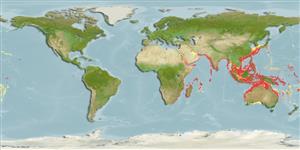Environment: milieu / climate zone / depth range / distribution range
Ecologie
marien; zoet water; brak water demersaal; katadroom (Ref. 51243); diepte 20 - 350 m (Ref. 58488). Tropical; 26°C - 29°C (Ref. 4959); 36°N - 35°S, 20°E - 167°W
Indo-Pacific: Red Sea and East Africa to Samoa, north to southern Japan, south to the Arafura Sea (Ref. 9819), Australia, and Lord Howe Island.
Lengte bij maturiteit / Grootte / Gewicht / Leeftijd
Maturity: Lm 13.0, range 9 - 17 cm
Max length : 36.0 cm TL mannelijk / geslacht onbekend; (Ref. 9710); common length : 25.0 cm SL mannelijk / geslacht onbekend; (Ref. 4967)
Dorsale stekels (totaal): 11 - 12; Dorsale zachte stralen (totaal): 9-11; Anale stekels 3; Anale zachte stralen: 7 - 10. Diagnosis: This species is distinguished by the following characters: body oblong moderately and laterally compressed, greatest body depth 2.5-3.2 times in standard length; head length 2.3-2.6 times in standard length; lower opercular spine extending well beyond the opercular flap; posttemporal bone exposed and serrate posteriorly; pectoral fin rays 13-14; gill rakers 6-8 +13-16 = 19-24; pored lateral line scales 75-100; horizontal scale rows above lateral line 13-17; caudal fin emarginate (Ref. 48274, 90102).
Found over shallow sandy bottoms, in the vicinity of river mouths. Enter estuaries and rivers (Ref. 1479, 11230, 44894, 48635), juveniles and adults are often found in freshwater (Ref. 4327). Adults in loose aggregations (Ref. 48635). Juveniles common in sandy intertidal areas; often in tidal pools. Minimum depth reported is 20 m (Ref. 12260). Found in schools (Ref. 9710). Omnivorous (Ref. 7300), feeding on fishes, insects, algae, and sand-dwelling invertebrates (Ref. 9710). Spawn in the sea and juveniles migrate into fresh water (Ref. 2847). Eggs are guarded and fanned by the male parent (Ref. 205). Produce sound (Ref. 9137). Caught on all types of inshore fishing gear including gill nets, traps, handlines, and bottom trawls and marketed fresh and dried-salted (Ref. 48274).
Eggs are guarded and fanned by the male parent (Ref. 205).
Paxton, J.R., D.F. Hoese, G.R. Allen and J.E. Hanley, 1989. Pisces. Petromyzontidae to Carangidae. Zoological Catalogue of Australia, Vol. 7. Australian Government Publishing Service, Canberra, 665 p. (Ref. 7300)
Status op de Rode Lijst van het IUCN (Ref. 130435)
Gevaar voor de mens
Harmless
Gebruik door de mens
Visserij: van minder commercieel belang; Aquacultuur: commercieel
Tools
Speciale rapporten
Download XML
Internetbronnen
Estimates based on models
Preferred temperature (Ref.
123201): 17.6 - 27.9, mean 23.7 °C (based on 917 cells).
Fylogenetische diversiteitsindex (Ref.
82804): PD
50 = 0.6250 [Uniqueness, from 0.5 = low to 2.0 = high].
Bayesian length-weight: a=0.01585 (0.01287 - 0.01951), b=3.02 (2.96 - 3.08), in cm total length, based on LWR estimates for this species (Ref.
93245).
Trofisch niveau (Ref.
69278): 3.9 ±0.5 se; based on diet studies.
Generation time: 4.6 ( na - na) years. Estimated as median ln(3)/K based on 2
growth studies.
Weerstandsvermogen (Ref.
120179): Gemiddeld, minimale populatieverdubbelingstijd 1,4-4,4 jaar (K=0.24).
Fishing Vulnerability (Ref.
59153): Moderate vulnerability (37 of 100).
Nutrients (Ref.
124155): Calcium = 116 [71, 223] mg/100g; Iron = 1.11 [0.71, 1.75] mg/100g; Protein = 18.4 [17.5, 19.2] %; Omega3 = 0.306 [0.183, 0.494] g/100g; Selenium = 62.8 [32.1, 121.9] μg/100g; VitaminA = 37.9 [14.6, 97.9] μg/100g; Zinc = 1.19 [0.84, 1.68] mg/100g (wet weight);
